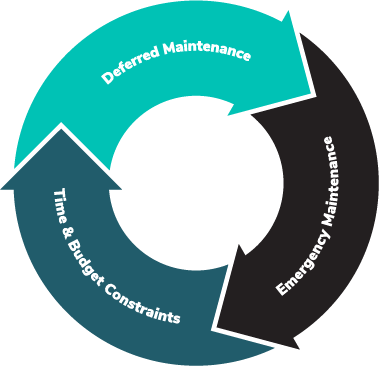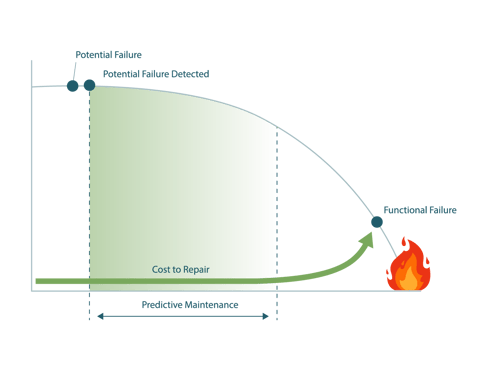The Ultimate Guide to Predictive Maintenance for Facility Management
In recent years, the term predictive maintenance has risen to prominence in the industrial and manufacturing sectors. For manufacturing, the benefits of this innovative, data-based maintenance strategy have been substantial. However, these benefits are not exclusive to the manufacturing sector. Experts agree that building maintenance programs can achieve similar success with predictive maintenance adoption, but for the built environment, predictive maintenance remains in its infancy.

What is predictive maintenance?
Predictive maintenance is an equipment maintenance strategy that relies on real-time monitoring of equipment conditions and data to predict equipment failures. Advanced data models, analytics, and machine learning (ML) can reliably assess when and where failures are most likely to occur, including which components are most likely to be affected.
Predictive maintenance vs. preventive maintenance vs. reactive maintenance
In the past, building maintenance used to be reactive otherwise known as corrective or run-to-failure maintenance. In the early 20th century, however, preventive maintenance emerged as a way to plan maintenance in advance to keep breakdowns from affecting operations.
Preventive maintenance is performed on a fixed schedule and consists of check-point processes and activities on building equipment. Time and run-time-based preventive maintenance can help reduce heightened service costs associated with reactive and run-to-failure maintenance strategies.

However, for many maintenance and repair (M&R) programs, the lack of a deliberate maintenance strategy results in reactionary M&R as corrections of failures become normal daily operations and absorb significant operating budgets. This becomes cyclical as M&R is deferred and in turn accelerates the deterioration of facility equipment which contributes to increased energy usage and energy spend.
Today, many leaders of building engineering programs agree that proactive maintenance is the optimal strategy for their M&R programs. But even preventive maintenance – the most common proactive maintenance strategy – can still result in increased maintenance spending by relying on potentially unnecessary inspections and unnecessary repairs. And despite all this, due to time and labor constraints, 60% of maintenance performed remains reactionary and perpetuates the reactionary M&R cycle.
Fortunately, the digitization of building equipment and systems provides an opportunity to optimize the proactive maintenance strategy by arming it with data. Predictive maintenance relies on large amounts of data and information to inform machine learning (ML) processes that improve maintenance efforts while strategically reducing unnecessary and reactionary repairs.
How does predictive maintenance work?
Predictive maintenance uses historical and real-time data from a building’s entire ecosystem of connected systems, equipment, sensors, external factors, and usage to model performance and anticipate equipment or system failure before it occurs.
This data is used to model what is called the P-F curve. The P-F curve depicts the performance of a piece of equipment or system over time and represents the point at which that equipment could fail – the potential failure or “P” in the equation – and the point at which that equipment does fail – the functional failure or “F” in the equation.
The more data that is available to inform this model, the better equipped a predictive maintenance program is to identify the interval between the potential failure point and the functional failure point.
A successful predictive maintenance program utilizes a strategic convergence of the Internet of Things (IoT), machine learning (ML), and system integration to leverage the vast amounts of data produced to model a P-F curve that can pinpoint the interval when failure is likely to occur with impeccable accuracy.

The P-F curve depicts the performance of a piece of equipment or system over time and represents the point at which that equipment could fail – the potential failure or “P” in the equation – and the point at which that equipment does fail – the functional failure or “F” in the equation.

What are the benefits of predictive maintenance?
A smart building predictive maintenance strategy results in facility maintenance and repairs being performed just before failure is like to occur. It also helps to optimize performance by indicating issues that result in equipment performance and inefficiencies. This allows for targeted maintenance that reduces unnecessary inspections and repairs and enables early intervention to prevent serious and complex problems down the line.
Other benefits of predictive maintenance include:
- Longer lifespan of equipment
- Lower maintenance costs
- Less equipment downtime
- Enhanced routine maintenance activities
- Budget control
What are the disadvantages and challenges of implementing predictive maintenance?
While predictive maintenance has its benefits, it isn’t without some disadvantages. There is of course an upfront cost associated with predictive maintenance. Aside from that, for it to be effective, the technology solutions must be integrated to access the vast amounts of data produced by the various building entities.
Furthermore, if done incorrectly, this integration can result in additional costs and downtime down the road as new technologies need additional integration work to bring them into the digital building ecosystem. Hiring a trusted master systems integrator (MSI) can help minimize these disadvantages.
Another disadvantage of predictive maintenance is that accurate interpretation of the resulting performance models often requires a new or elevated skill level and experience. Leveraging the managed services provided through your software provider and outsourcing this function can offset this need.
Other disadvantages and challenges include:
- The data challenge
A predictive maintenance strategy is only as good as the data it uses. A number of factors including reliance on human input and data modeling and communication protocol inconsistencies, all make it increasingly challenging for the built environment to effectively adopt predictive maintenance programs. - The processes and procedures challenge
Assuming the data challenge has been overcome, a new challenge emerges. With a stream of accurate, reliable, and consistent data comes an inundation of information and insights about potential equipment failures and inefficiencies which can overwhelm maintenance teams with alerts and alarms. - The adoption challenge
The adoption of analytics software to the facility management technology stack can seem like an additional chore for users. Aside from the learning curve associated with new software, new technologies often require changes to the status quo of users.
Learn how partnering with the right software and managed services provider can help you overcome these challenges in the Predictive Maintenance whitepaper.
Implementing predictive maintenance across your real estate portfolio
There are several considerations to account for when deciding on the adoption of a predictive maintenance strategy for your portfolio. It’s necessary to address these considerations in a thoughtful and strategic manner.
The steps you should take in implementing a predictive maintenance strategy include:
- Set goals and priorities
- Establish a timeline
- Assess your ecosystem
- Address equipment and technology gaps
- Ensure building data is useable
- Connect and turn on software
Get a detailed explanation of each of these steps in our Predictive Maintenance whitepaper.
Going beyond predictive maintenance.
Now that your predictive maintenance program is actively producing insights from your connected equipment consider integrating and automating those analytics into your computerized maintenance management systems (CMMS), asset management, or work order systems. An additional benefit of predictive maintenance is the ability to provide contractors with advanced fault detection and diagnostics (FDD) such as precise equipment information, the root cause or predictive issues, and verification of work completion.
Setting expectations.
A successful predictive maintenance program will most likely take months or years to fully implement but when done with these expectations in mind, it will be best aligned with your resources, budget, and needs without overwhelming your already busy schedule. A methodical approach that manages expectations ensures effective adoption and buy-in from stakeholders while ensuring your program is built according to your goals.
Ready to start your Predictive Maintenance program?
Speak to a adaptive buildings expert today to learn more.
